Nov. 25, 2025
Prelims Pointers
Nov. 25, 2025

About Capital Gains Account Scheme (CGAS), 1988:
- It was introduced by the Central Government in 1988 to help taxpayers claim exemptions on long-term capital gains.
- Under Section 54 of the Income Tax Act, income from capital gains must be reinvested within 3 years to avoid tax liability.
- However, there could be instances when the due date for filing income tax falls during this specified tenure.
- If a taxpayer is unable to invest in such a short period of time, they can deposit such underutilised capital gains under CGAS.
- However, taxpayers must deposit such funds before filing their Income Tax Returns.
- Investing the gains in this account is treated the same as direct reinvestment for exemption purposes.
- However, short-term capital gains are not eligible for the CGAS, as exemptions apply only to long-term capital gains.
- Who Can Deposit in CGAS?
- Any taxpayer who earns long-term capital gains and wants to claim exemption can deposit in the CGAS.
- This includes Individuals, Hindu Undivided Families (HUFs), Companies, Trusts, and any other person eligible for capital gains exemption.
- The scheme is mainly used when the taxpayer is unable to reinvest the capital gains before the due date of filing their income tax return but intends to invest within the specified period to claim exemption.
- The deposited amount must then be used within the stipulated period to invest in the eligible asset; otherwise, it will be treated as taxable capital gain in the year the deadline expires.
Capital Gains Accounts (Second Amendment) Scheme, 2025:
- Previously, CGAS deposits were largely limited to public sector banks and a few older institutions.
- Under the new notification, all non-rural branches of 19 major private banks are now authorised to receive deposits and maintain CGAS accounts.
- The “non-rural branch” condition means that only branches at centres with population 10,000 or more (per 2011 census) are in scope.
- The amended scheme explicitly defines ‘electronic mode’ of deposit to include credit/debit cards, net banking, UPI, IMPS, RTGS, NEFT, BHIM/Aadhaar Pay etc.
Prelims Pointers
Nov. 25, 2025

About Special Leave Petition (SLP):
- A SLP is a request made to the Supreme Court of India seeking special permission to appeal against any judgment, order, or decree from any court or tribunal (except military tribunals), even when the law does not provide a statutory right of appeal.
- In other words, SLP is not a right—it's a privilege granted by the Supreme Court at its discretion.
- Article 136 states that the Supreme Court may, in its discretion, grant special leave to appeal from any judgment, decree, determination, or order from any court or tribunal in India.
- It can only be exercised when a substantial question of law or gross injustice has been committed.
- A judgement, decree, or order need not be final for an SLP. An interim or interlocutory order, decree, or judgement can also be challenged.
- It is a discretionary/optional power of the SC, and the court can refuse to grant the appeal at its discretion.
- The aggrieved party can’t affirm a special leave to offer under Article 136 as a right.
- SLP can be filed by:
- Any aggrieved party (individual or business)
- Government bodies
- Public sector undertakings
- NGOs or associations (in relevant cases)
- The key requirement is that the party must be aggrieved by the impugned judgment or order.
- An SLP can be filed for any civil or criminal matter, etc.
- SLP can be filed against judgments from:
- High Courts
- Tribunals (except those under armed forces)
- Quasi-judicial bodies
- Time limit to file SLP:
- It can be filed against any judgment of the High Court within 90 days from the date of judgment or
- It can be filed within 60 days against the order of the High Court refusing to grant the certificate of fitness for appeal to SC.
- Procedure for a SLP:
- A SLP must contain all the facts upon which the SC is to decide, which revolve around the grounds on which an SLP can be filed.
- The said petition needs to be duly signed by an Advocate-on-Record.
- The petitioner must include a statement within the SLP stating that no other petition has been filed in a High Court.
- Once the petition is filed, the SC will hear the aggrieved party and depending upon the merits of the case, will allow the opposite party to state their part in a counter affidavit.
- After the hearing, if the court deems the case fit for further hearing, it will allow the same; otherwise it will reject the appeal.
Prelims Pointers
Nov. 25, 2025

About Bharat NCAP:
- The Bharat New Car Assessment Programme (Bharat NCAP) is an indigenous star-rating system for crash testing cars, under which vehicles will be assigned between one to five stars, indicating their safety in a collision.
- It is an ambitious joint project between the Government of India (GoI) and Global NCAP, the regulatory body behind the safety crash test ratings.
- Objective: To help consumers make an informed decision before purchasing a car, thereby spurring demand for safer cars.
- Under the Bharat NCAP, cars voluntarily nominated by automobile manufacturers will be crash tested as per protocols laid down in the Automotive Industry Standard (AIS) 197.
- Vehicles tested under the Bharat NCAP are evaluated across three critical safety domains: adult occupant protection, child occupant protection, and safety assist technologies.
- Applicability:
- Only right-hand drive passenger vehicles on sale in India and weighing less than 3,500 kg are eligible for consideration.
- Base variants of cars are to be tested, and ratings will be applicable for four years.
- Besides internal combustion engine (ICE) models, CNG cars as well as battery-powered electric vehicles are eligible to undergo the safety test.
- It is a voluntary programme under which the cost of the car for assessment for star rating and the cost of such assessment are borne by the respective vehicle manufacturer or importer.
- Bharat NCAP is overseen by the Ministry of Road Transport, but is an independent body.
- The current Bharat NCAP regulations remain valid until September 30, 2027, after which Bharat NCAP 2.0 is expected to be implemented by October 2027.
Bharat NCAP 2.0 Proposed Guidelines:
- It brings in fresh mandatory tests, revised scoring methods, and updated safety verticals.
- Notably, for the first time, vehicles will be assessed on vulnerable road user protection.
- The Bharat NCAP 2.0 proposal introduces a 100-point rating system across five pillars: Crash Protection, Vulnerable Road-User Protection, Safe Driving, Accident Avoidance, and Post-Crash Safety.
- The crash test will be expanded from two to five and will now have Male, female, and child dummies for testing.
- The cars will go through offset frontal impact, full-width frontal impact, side impact, pole side impact, and rear impact.
- Electronic stability control (ESC) and curtain airbags will be compulsory for any model seeking a star rating.
- Autonomous emergency braking (AEB) remains optional. Models with side-facing seats will not be eligible for a rating.
- From 2027-29, a 5-star rating will require 70 points, and this would rise to 80 points from 2029-31.
- Minimum scores will also apply across each pillar.
Prelims Pointers
Nov. 25, 2025
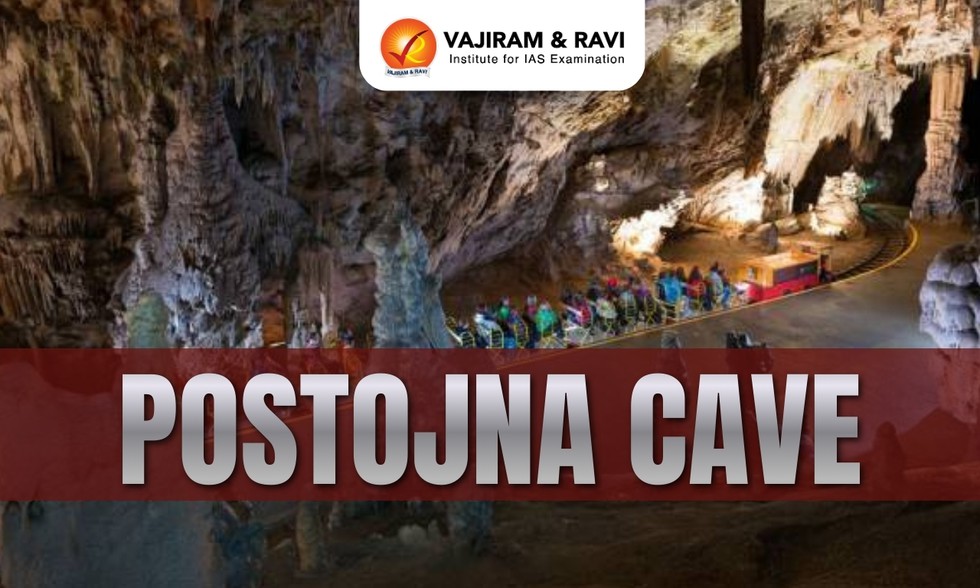
About Postojna Cave:
- It is located in western Slovenia.
- It is a limestone cave carved out by the Pivka River over millions of years.
- It is the only karst cave with a railway.
- The cave system hosts Proteus anguinus — a blind, colorless, snake-like amphibian, with both lungs and gills, feeding on snails and worms.
Prelims Pointers
Nov. 25, 2025
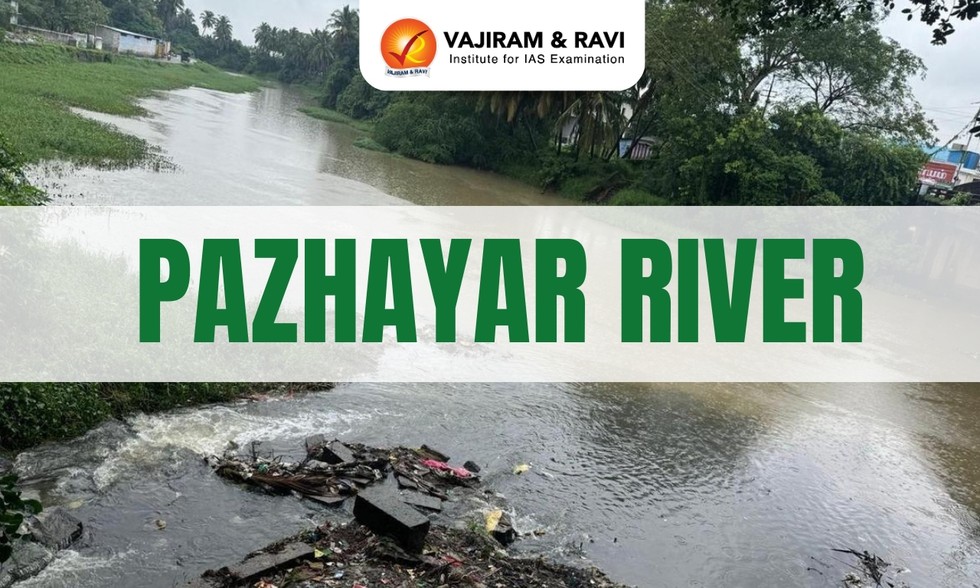
About Pazhayar River:
- It is a major river flowing in the Kanniyakumari district of Tamil Nadu.
- Course:
- It originates from the slopes of Mahendragiri hills.
- It flows towards southwestern direction and joins the Arabian Sea near Manakudi.
- Alathurayar, Poigaiyar, Thadaveyar, Koya odai, and Ulakkaruviyar are the major tributaries of the Pazhayar River.
- Chattupythur dam, Chettothoppu dam, Cholanmkattu dam, Kutty dam, Kumari dam, Mission dam, Pallikondam dam, Pillaipetha dam, Salari dam, Veerapuli dam, and Veeranarayanamangalam are some of the dams constructed in the Pazhayar River.
- The Manakudi Estuary at its mouth is ecologically sensitive and rich in mangroves, birds, and marine life.
Prelims Pointers
Nov. 25, 2025

About HAMMER Weapon System:
- The HAMMER (Highly Agile and Manoeuvrable Munition Extended Range) is an air-to-ground precision-guided weapon system developed by Safran, a French aerospace and defence company.
- It is also known as a glide bomb.
- Features of HAMMER Weapon System:
- Range: HAMMER precision-guided munitions have a range of up to 70 km.
- It can be fitted to standard bombs of 250kg, 500kg, and 1,000kg weights.
- It is resistant to jamming, and capable of being launched from low altitudes over rough terrain.
- It is difficult to intercept and can penetrate fortified structures.
- Design and Capabilities: It is a precision-guided weapon system known for its high accuracy and modular design, making it adaptable for multiple platforms, including the Rafale and Light Combat Aircraft Tejas.
What is a Precision-Guided Weapon system?
- It is a guided weapon intended to destroy a point target and minimize collateral damage.
- These are also known as "smart bombs”.
- These systems incorporate a guidance system (typically in the front of the precision munition), a payload, and fins.
Prelims Pointers
Nov. 25, 2025
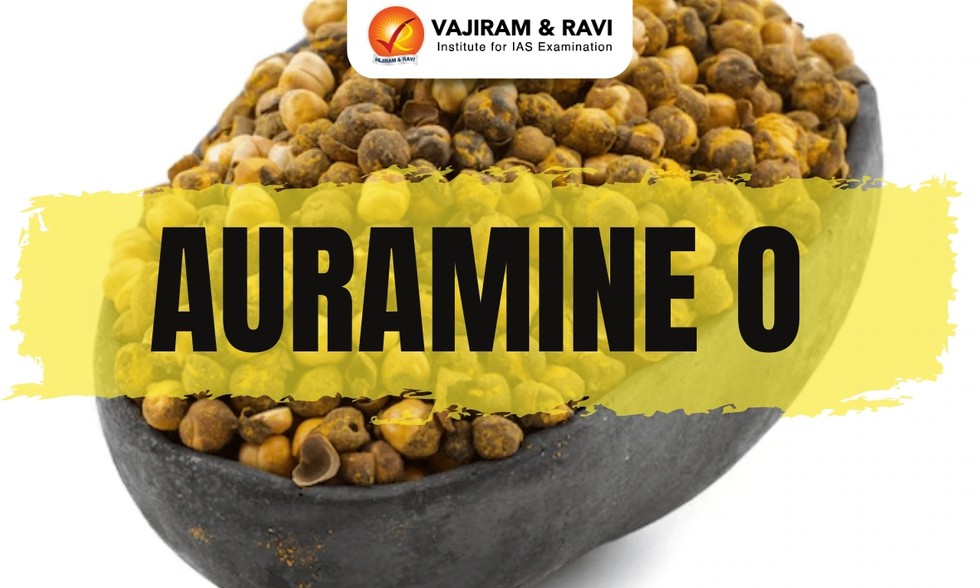
About Auramine O:
- It is a synthetic yellow dye produced from compounds such as dimethylaniline and formaldehyde.
- The dye appears as yellow flakes or powder and dissolves easily when mixed with solvents.
- It is not approved for use as a food colour in India, the European Union, and the United States.
- Applications of Auramine O: It is extensively used in industry, including textile and leather processing, printing inks, paper manufacturing, and certain microbiological staining procedures.
- Impacts on Human Health: It creates health risks like liver and kidney damage, enlargement of the spleen, mutagenic effects that can alter genetic material, and potential carcinogenic outcomes.
- Global context: It is classified as an industrial dye by the regulators in the S., EU, and East Asian nations and its presence in consumables triggers product recalls and import alerts.
- The International Agency for Research on Cancer (IARC) classifies auramine as a substance that is possibly carcinogenic to humans.
Prelims Pointers
Nov. 25, 2025

About Hayli Gubbi Volcano:
- Location: It is located in Ethiopia’s Afar region, in northeast of Addis Ababa near the Eritrean border.
- It is a shield volcano that sits within Ethiopia’s Danakil Depression, one of the hottest and most remote areas on the planet.
- It is the southernmost volcano in the Erta Ale range.
- The Erta Ale range is known for its persistent lava lakes and is primarily made up of shield volcanoes.
- Hayli Gubbi has no previously recorded eruptions in modern history.
Key Facts about Shield volcano:
- They are the largest volcanoes on Earth
- They are almost exclusively basalt (a type of lava that is very fluid when erupted).
- These volcanoes are not steep. They are broad volcanoes with gentle slopes.
- They are built by repeated eruptions that occurred intermittently over vast periods of time.
What is Ash cloud?
- An ash cloud forms when a volcano erupts and sends volcanic materials into the atmosphere.
- It contains fine volcanic ash, sulphur dioxide, and tiny fragments of rock and glass.
- It has an adverse effect on human health, causing respiratory problems, eye irritation and skin discomfort.
Prelims Pointers
Nov. 25, 2025
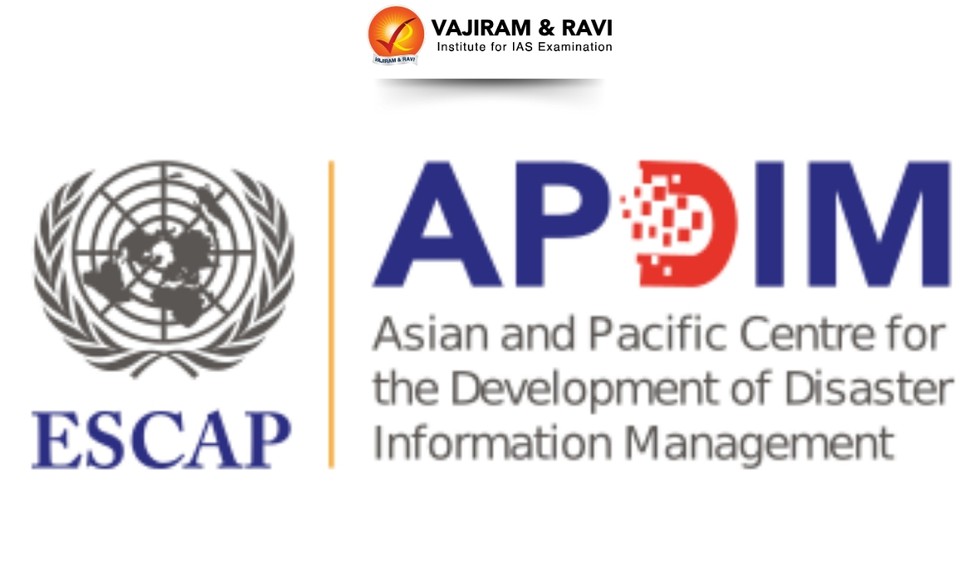
About Asian and Pacific Centre for Development of Disaster Information Management:
- It is a regional institution of the United Nations Economic and Social Commission for Asia and the Pacific (ESCAP).
- Vision: To ensure effective disaster risk information is produced and used for sustainable development in Asia and the Pacific.
- Mandate: To reduce human and material losses due to natural hazards and contribute to the effective design, investment and implementation of disaster risk reduction and resilience policies.
- Governance: It is governed by a Governing Council consisting of eight ESCAP member countries elected for a period of three years (India is one of the members for a period from 2022 to 2025).
- Headquarter: Tehran, Iran.
- Functions of Asian and Pacific Centre for Development of Disaster Information Management
- Risk Information and Knowledge Repository: It functions as a regional facility to strengthen the science-policy interface.
- Information Capacity and Application: It facilitates the exchange of expertise, experiences, and knowledge in disaster information management between and within the countries of the region.
- Regional Cooperation and Coordination for Disaster Risk Information: It promotes effective regional cooperation, facilitate dialogue.
Prelims Pointers
Nov. 25, 2025

About Information Security Education and Awareness Project:
- It is an initiative of the Ministry of Electronics and Information Technology (MeitY), Government of India.
- Purpose: Generating human resources in the area of Information Security and creating general awareness on cyber hygiene/cyber security among the masses.
- Aim: It is aimed at human resources development for safe, trusted, and secure cyber space.
- Implementation of Information Security Education and Awareness Project:
- The project is implemented through select 50 institutions in a hub-n-spoke mode, comprising:
- Premier Academic Institutionse. IITs, NITs, IIITs, etc.
- Autonomous Organizations of MeitY i.e. C-DAC & NIELIT
- Technical Universities
- The project is implemented through select 50 institutions in a hub-n-spoke mode, comprising:
Key Facts about Cyber Security Innovation Challenge (CSIC) 1.0:
- It is an initiative of the Ministry of Electronics and Information Technology (MeitY)
- It was launched for students and researchers to work upon real-world cyber challenges.
- It is strategically designed to foster indigenous, research-driven cyber security solutions from the academic ecosystem.
- It would focus on problem statements across 10 domains;
- Computer & Network Security; Mobile Device Security; Systems & Software Security; Hardware Security; Security in Futuristic Technologies; Cryptography; Security in Distributed Wireless Networks; Cyber Forensics; Governance, Operations & Services; and Fintech Security.
Nov. 24, 2025
Prelims Pointers
Nov. 24, 2025

About Brihadeeswarar Temple:
- It is a Hindu temple dedicated to Shiva located in Thanjavur, Tamil Nadu.
- It is also known as Periya Kovil, RajaRajeswara Temple and Rajarajesvaram.
- It is one of the largest temples in India and is an example of Dravidian architecture during the Chola period.
- It was built by emperor Raja Raja Chola I and completed in 1010 AD.
- It is part of the UNESCO World Heritage Site known as the “Great Living Chola Temples”, with the other two being the Brihadeeswarar Temple, Gangaikonda Cholapuram and Airavatesvara temple.
- Architecture:
- The temple stands amidst fortified walls that were probably added in the 16th century.
- ‘The vimanam (temple tower) is 216 ft (66 m) high and is the tallest in the world.
- The Kumbam (the apex or the bulbous structure on the top) of the temple is carved out of a single rock and weighs around 80 tons.
- The temple complex spans over 40 acres and is decorated with masses of sculptures and inscriptions that spotlight the era's devotion and craftsmanship.
- There is a big statue of Nandi (sacred bull), carved out of a single rock measuring about 16 ft (4.9 m) long and 13 ft (4.0 m) high at the entrance.
- The entire temple structure is made out of granite.
Prelims Pointers
Nov. 24, 2025

About African Grey Parrot:
- It is a medium-sized, dusty-looking gray bird.
- Scientific Name: Psittacus erithacus
- It is one of the most talented talking/mimicking birds on the planet.
- Habitat and Distribution:
- African grey parrots are native to West and Central Africa.
- They inhabit different types of lowland forest, including rainforest, woodlands, and wooded savannah.
- They can be seen along forest edges and in clearings as well, and sometimes feeding in gardens and cultivated fields.
- They are kept as pets in many parts of the world, and their popularity dates back centuries.
- Features:
- It is a mottled grey-colored, medium-sized parrot.
- It has a large black bill and white mask enclosing a yellow eye and has a striking red vent and tail.
- Females have a pale gray crown with dark gray edges, a gray body, and scarlet tail feathers.
- The male looks similar to the female but becomes darker with age.
- Lifespan: 50+ years
- Conservation Status:
- IUCN Red List: Endangered.
Prelims Pointers
Nov. 24, 2025
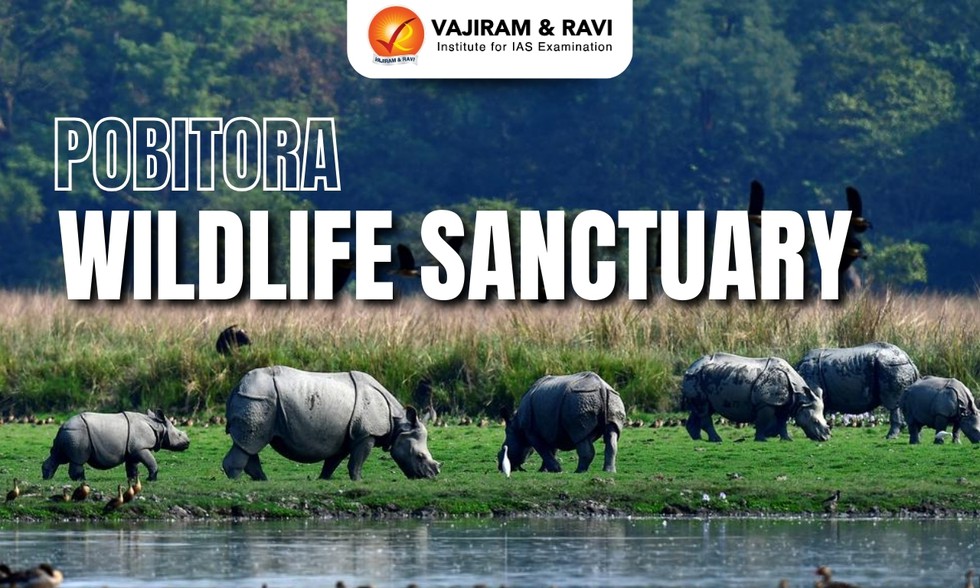
About Pobitora Wildlife Sanctuary:
- It is located in the eastern region of Guwahati, Assam.
- It is in close proximity to the Mayong village that is renowned as the Black magic capital of India.
- This wildlife sanctuary was established in 1998 with a total area of 48.81 sq.km.
- The sanctuary consists of the Rajamayong Reserve Forest and Pobitora Reserve Forest.
- The region was once part of the vast floodplains of the Brahmaputra River and was known for its rich flora and fauna.
- History:
- Pobitora became a reserved wooded area in the year of 1971 with the approval of the Government of Assam Tourism.
- The Government of India included Pobitora Wildlife Sanctuary with the association of a rhino breeding program named “Indian Rhino Vision 2020”.
- The landscape is dominated by alluvial grasslands and dense patches of tall elephant grass.
- Flora:
- 72% of Pabitora consists of the wet savannah of Arundo donax, Erianthus ravennae, Phragmites karka, Imperata cylindrica, and Saccharum spp.
- Water hyacinth (Eichornia crassipes) is a major problem, especially to waterfowl, as it forms thick mats on the water surface.
- Fauna:
- It is known for holding the highest density of Greater One Horned Rhinoceros in the country.
- Besides rhinoceros, the other animals are leopard, wild boar, Barking deer, wild buffalo, etc.
- It is also home to more than 2000 migratory birds and various reptiles.
Prelims Pointers
Nov. 24, 2025

About Hussain Sagar Lake:
- It is an artificial lake located in Hyderabad, Telangana.
- It is also called Tank Bund and lies on a tributary of River Musi.
- It spreads across an area of 5.7 sq.km. It is one of the largest man-made lakes in Asia.
- It is the largest heart-shaped mark among the marks formed by 78 heart-shaped lakes and 9 heart-shaped islands on the face of the earth.
- It was built during the reign of Ibrahim Quli Qutub Shah by Hussain Shah Wali in 1562
- It is renowned for its monolith of Lord Buddha that stands right in its centre.
- It had been of significance in the early days since it connected the twin cities of Hyderabad and Secunderabad.
- Till 1930, the lake was used for irrigation and drinking water requirements.
- Over the years, Hussain Sagar Lake has become polluted through the entry of untreated sewage and industrial effluents through the nalas that flow into the lake.
Prelims Pointers
Nov. 24, 2025

About Dorjilung Hydroelectric Power Project:
- It is a planned 1125 MW run-of-river project situated in the eastern Lhuentse and Mongar Districts of Bhutan on the Kurichhu River, a tributary of the Drangmechhu that flows into India.
- At a height of approximately 139.5 m, the concrete-gravity dam channels nearly 287 m3/s through a 15 km headrace tunnel to an underground powerhouse housing six Francis turbines, designed to generate around 4.5 terawatt-hours (TWh) annually.
- At a total project cost of ₹13,100 crore, Dorjilung will be Bhutan’s second-largest hydropower project, and the largest Public–Private Partnership (PPP) hydro project ever undertaken in the country.
- The project is financed by the World Bank.
- In November 2024, Bhutan’s Druk Green Power Corporation (DGPC) signed an MoU with Tata Power Company Limited for the joint development of the project.
- The Project will be implemented through a Special Purpose Vehicle (SPV), with DGPC and Tata Power holding equity shares of 60% and 40%, respectively.
- The project is expected to be commissioned by early 2032.
Prelims Pointers
Nov. 24, 2025

About Georgia:
- Location: It is located in the far south eastern region of the European continent.
- Georgia is a Transcaucasian country, situated at the dividing line of the continents of Asia and Europe.
- Bordering Countries: It is bordered by 4 countries: by Russia in the north and northeast; by Azerbaijan in the east and southeast; and by Armenia and Turkey in the south.
- Maritime Border: Georgia is bounded by the Black Sea in the west.
- Capital City: Tbilisi
- Geographical Features of Georgia:
- Terrain: It is largely mountainous with Great Caucasus Mountains in the north and Lesser Caucasus Mountains in the south.
- Climate: It is temperate and ranges from subtropical mediterranean in the west to arid and warm in the east.
- Highest Peak: Mount Shkhara (5,068 metres) is the highest point of Georgia.
- Major Rivers: Inguri, Kodori, Mtkvari and Rioni
- Natural Resources: It mainly consists of manganese deposits, iron ore, copper, minor coal and oil deposits.
Prelims Pointers
Nov. 24, 2025

About Moss Plant:
- It is a small nonvascular spore-bearing land plant belonging to the taxonomic division Bryophyta.
- Mosses existed as early as the Permian Period and more than 100 species have been identified from fossils of the Paleogene and Neogene periods.
- It is among the earliest land plants and has colonised some of the harshest environments on the planet, including Antarctica, volcanic fields, and deserts.
- Types of Moss: Of the 10,000 and more types of mosses on the planet, there are three main types: peat moss, granite moss and true moss.
- Distribution: Mosses are distributed throughout the world except in salt water.
- Habitat: It is the small plant commonly found in damp, shady spots is already known for its resilience on Earth.
- Moss reproduces through spores, which are the equivalent to a flowering plant’s seed.
- Ecological Significance:
- Ecologically, mosses break down exposed substrata, releasing nutrients for the use of more-complex plants that succeed them.
- They also aid in soil erosion control by providing surface cover and absorbing water.
- They are important in the nutrient and water economy of some vegetation types.
- Mosses can be effective indicators of c02 emissions that pollute the air. They can also signal if an ecosystem has been damaged or harmed by acid rain.
Prelims Pointers
Nov. 24, 2025
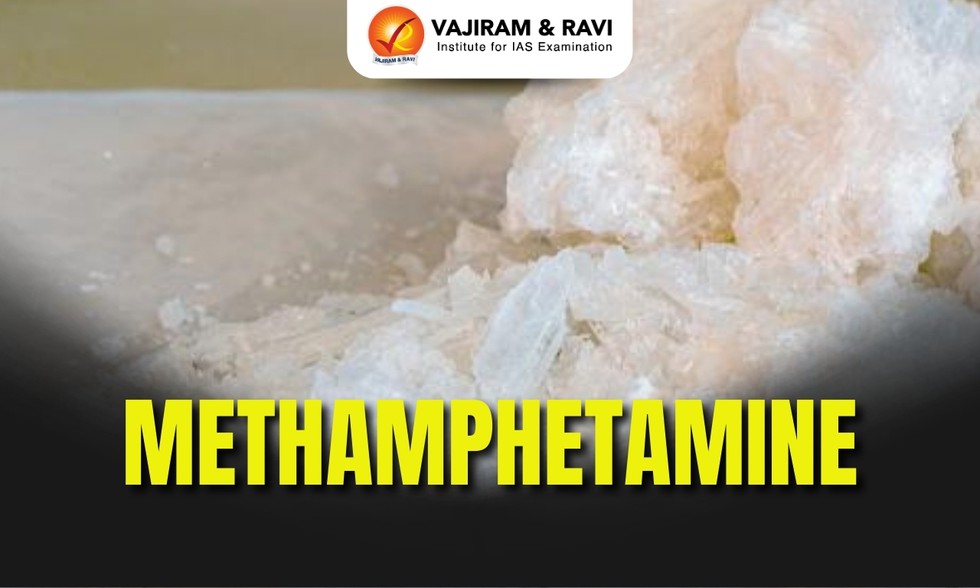
About Methamphetamine:
- Methamphetamine is a powerful, highly addictive stimulant that affects the central nervous system.
- It is also known as meth, chalk, ice, and crystal.
- It was developed early in the 20th century from its parent drug, amphetamine, and was used originally in nasal decongestants and bronchial inhalers.
- Properties of Methamphetamine:
- It is a member of the class of amphetamines.
- It takes the form of a white, odorless, bitter-tasting crystalline powder that easily dissolves in water or alcohol.
- Methamphetamine is potent and easy to produce.
- It has a role as a neurotoxin, a psychotropic drug, a central nervous system stimulant, a xenobiotic and an environmental contaminant.
How does it Affect Humans?
- Like amphetamine, methamphetamine causes increased activity and talkativeness, decreased appetite, and a pleasurable sense of well-being or euphoria.
- The use of methamphetamine in higher doses can induce psychosis, bleeding in the brain, skeletal muscle breakdown, and seizures.
- It can cause violent behavior, mood swings, and psychosis such as paranoia, delirium, auditory and visual hallucination, and delusions when used chronically.
- Chronic long-term methamphetamine use can be highly addictive, and if it is discontinued abruptly, it might lead to withdrawal symptoms.
Prelims Pointers
Nov. 24, 2025

About Limestone:
- Limestone is a sedimentary rock made of calcium carbonate (CaCO3), usually in the form of calcite or aragonite.
- It occurs across almost all geological sequences from Pre-Cambrian to Recent, except in Gondwana formations.
- Composition of Limestone:
- It contains considerable amounts of magnesium carbonate (dolomite).
- It also contains minor constituents of clay, iron carbonate, feldspar, pyrite, and quartz.
- In many cases, the grains are microscopic fragments of fossil animal shells that are also present.
- Distribution in India: Karnataka has the largest share (28%) of total resources, followed by Andhra Pradesh, Rajasthan, Gujarat, Meghalaya, and Chhattisgarh.
- Production Centers: Over three-fourths of India’s limestone is produced in just six states: Andhra Pradesh & Telangana, Rajasthan, Madhya Pradesh, Gujarat, Tamil Nadu, and Karnataka.
- Uses of Limestone:
- The principal use of limestone is in the Cement Industry.
- Metallurgical Processes: It is used as a flux in iron and steel production.
- Other Industries: Glass, Ceramic, Paper, Textile, and Tanning
- Chemical Production: Calcium carbide, alkali, bleaching powder
- Agriculture: It is used as soil conditioning agent and in fertilizer (calcium ammonium nitrate)
- Consumer Products: Whiting (chalk and precipitated limestone) in rubber, paint, cosmetics, toothpaste, and shoe polish.
Prelims Pointers
Nov. 24, 2025

About Exercise AUSINDEX:
- It is a bilateral exercise held between India and Australia.
- It is a major biennial maritime exercise which has been conducted since 2015.
- Aim: The exercise is aimed at significantly boosting interoperability and deepening the strategic partnership between the two maritime nations.
- Key Facts about Exercise AUSIDEX 2025:
- The warships and aircraft of both navies conducted intense joint operations, focusing on anti-submarine warfare, gunnery exercises, and advanced flying operations.
- The Indian Naval Ship INS Sahyadri, alongside HMAS Ballarat participated in the Exercise.
Other Exercises conducted between Australia and India:
- Ex AUSTRA HIND (Bilateral Exercise with Army)
- EX PITCH BLACK (Australia’s multilateral air combat training exercise)
- Malabar Naval Exercise
- Quad (Multilateral Naval Exercise).
Nov. 23, 2025
Prelims Pointers
Nov. 23, 2025

About Food Safety and Standards Authority of India (FSSAI):
- It is an autonomous body established under the Ministry of Health and Family Welfare, Government of India.
- It has been established under the Food Safety and Standards Act, 2006, which is a consolidating statute related to food safety and regulation in India.
- FSSAI is responsible for setting food standards, regulating the manufacture, storage, distribution, sale, and import of food, and ensuring the availability of safe and wholesome food for human consumption.
- It lays down the science-based standards for food articles and regulates their manufacturing and distribution processes.
- Functions:
- Standards Development: FSSAI formulates standards for various food products, ensuring they are safe for consumption.
- Food Safety Management Systems: It provides guidelines for businesses to implement effective food safety management practices.
- Licensing and Registration: FSSAI manages the licensing process for food businesses, ensuring they comply with food safety regulations.
- Surveillance and Monitoring: Regular inspections and audits are conducted to assess compliance with food safety standards.
- Consumer Awareness: Initiatives to educate the public about food safety, hygiene, and nutrition are a key focus area.
- Anyone selling or importing food in India needs a food licence issued by FSSAI.
- FSSAI also directly monitors compliance of food regulations, especially in the area of food imports to India.
- FSSAI officers carry out food import controls and ensure that they contain no harmful ingredients. To do this, they send selected test products from the import to accredited laboratories for inspection.
- The FSSAI is also responsible for the accreditation of food testing laboratories throughout India.
- FSSAI has notified 14 referral labs, 72 State/UT labs across India, and 112 NABL approved commercial labs, all of which are situated throughout the country.
Prelims Pointers
Nov. 23, 2025

About Sukhna Wildlife Sanctuary:
- It is a protected area located in Chandigarh, near the famous Sukhna Lake at the foothills of the Shivalik range.
- The lake was created by the architect Le Corbusier in 1958 by diverting the Sukhna Choe, a seasonal stream that flows down from the Shivalik hills.
- The sanctuary was developed as a result of afforestation done for soil conservation around Sukhna Lake.
- Spreading over an area of 2600 hectares, Sukhna Wildlife Sanctuary was established in 1998.
- The place is quite unstable geographically and becomes prone to soil erosion by surface runoff during rains.
- It has sandy soil of Shivalik with pockets of clay embedded at places.
- Apart from the Sukhna Lake, there are around 150 small and large water bodies in the sanctuary that form its catchment area.
- Vegetation: It is characterized by a mix of forests, grasslands, and wetlands, with the Sukhna Lake forming an important part of the ecosystem.
- Flora: The common flora of the sanctuary includes Khair, Phulai, Kikar, Shisham, Moonj, Amaltas, Jhingan, Amla, Rati, Vasaka, and many more.
- Fauna:
- Squirrels, Common-Mongoose, Indian Hare, Porcupine, Jungle Cat, Jackal, Wild boar, etc, are the mammals found in the sanctuary.
- It is known to have the most number of sambar (a type of antelope) found in a group or cluster than anywhere else in the country.
- Peacock, Hill myna, Jungle crow, Black drongo, Parrots, Doves, and others are the common birds of this region. Migratory birds also flock around this place.
Prelims Pointers
Nov. 23, 2025

About Microplastics:
- Microplastics are small pieces of plastics, usually smaller than 5 mm.
- They are present in a variety of products, from cosmetics to synthetic clothing to plastic bags and bottles. Many of these products readily enter the environment as wastes.
- Microplastics consist of carbon and hydrogen atoms bound together in polymer chains.
- Other chemicals, such as phthalates, polybrominated diphenyl ethers (PBDEs), and tetrabromobisphenol A (TBBPA), are typically also present in microplastics, and many of these chemical additives leach out of the plastics after entering the environment.
- They are persistent, very mobile, and hard to remove from nature.
- There are two categories of microplastics: primary and secondary.
- Primary microplastics are tiny particles designed for commercial use, such as cosmetics, as well as microfibers shed from clothing and other textiles, such as fishing nets.
- They enter the environment directly through any of various channels—for example, product use, unintentional loss from spills during manufacturing or transport, or abrasion during washing.
- Secondary microplastics are particles that result from the breakdown of larger plastic items, such as water bottles.
- This breakdown is caused by exposure to environmental factors, mainly the sun’s radiation and ocean waves.
- Impacts:
- Once in the environment, microplastics do not biodegrade and tend to accumulate and persist.
- They can be ingested by marine organisms, leading to potential harm to aquatic life and bioaccumulation along the food chain.
- They can also carry toxic chemicals and pollutants, posing additional risks to organisms and ecosystems.
Prelims Pointers
Nov. 23, 2025

About Strait of Malacca:
- It connects the Andaman Sea (Indian Ocean) and the South China Sea (Pacific Ocean).
- It runs between the Indonesian island of Sumatra to the west and peninsular (West) Malaysia and extreme southern Thailand to the east.
- The Strait of Malacca’s name was derived from the Malacca Sultanate, who governed the archipelago from 1400 until 1511.
- The strait has a width of about 890 kilometres and a depth of 25 meters.
- It has an area of about 25,000 square miles (65,000 sq.km.).
- The climate of the strait is hot and humid and is characterized by the northeast monsoon during the (northern) winter and the southwest monsoon during the summer.
- It links the Indian and Pacific oceans and is one of the busiest and most important shipping lanes in the world.
- Singapore, Malaysia, and Indonesia control the joint patrolling of the Malacca Strait.
- Significance:
- Roughly 60% of India’s seaborne trade and almost all of its LNG imports pass through the Malacca Strait.
- The route is also a choke point for Chinese shipping, which makes it strategically sensitive.
Prelims Pointers
Nov. 23, 2025
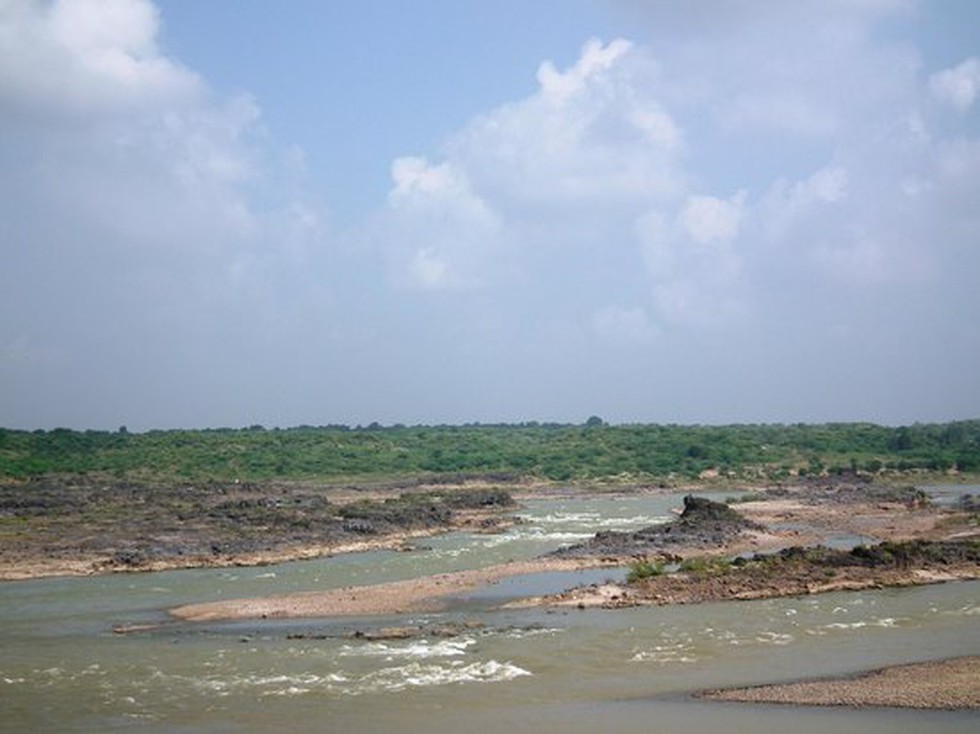
About Mahi River:
- It is one of the major west-flowing interstate rivers of India.
- It flows through the states of Madhya Pradesh, Rajasthan, and Gujarat.
- The river is popularly described as “Mahisagar” due to its vastness.
- Course:
- It originates in the northern slope of the Vindhya Mountain Range in Madhya Pradesh, at an average altitude of about 500 m above mean sea level.
- After its birth, the river flows in the southerly direction of Madhya Pradesh for about 120 km.
- It enters the southeastern portion of Rajasthan, which is the Vagad region.
- Before entering Gujarat, the river makes a `U`-shaped loop in Rajasthan.
- Finally, the river surrenders itself to the Arabian Sea by a wide estuary near Khambat.
- The total length of Mahi is 583 km.
- The Mahi basin extends over the states of Madhya Pradesh, Rajasthan, and Gujarat, having a total area of 34,842 sq.km.
- It is bounded by the Aravalli hills on the north and the northwest, by the Malwa Plateau on the east, by the Vindhyas on the south, and by the Gulf of Khambhat on the west.
- The silt brought down by the Mahi River has contributed to the thinning of the Gulf of Khambat and the abandonment of its once-rich ports.
- The riverbed lies considerably lower than the land level and is of little use for irrigation.
- Geological Features: Rocky stretches, rapids, waterfalls, canyons, and gorges define the river’s course.
- Tributaries: The Som is its principal tributary, which joins from the right, and the Anas and the Panam joins the river from the left.
- Dams: Mahi Bajaj Sagar Dam, Kadana Dam, and Panam Dam
Prelims Pointers
Nov. 23, 2025
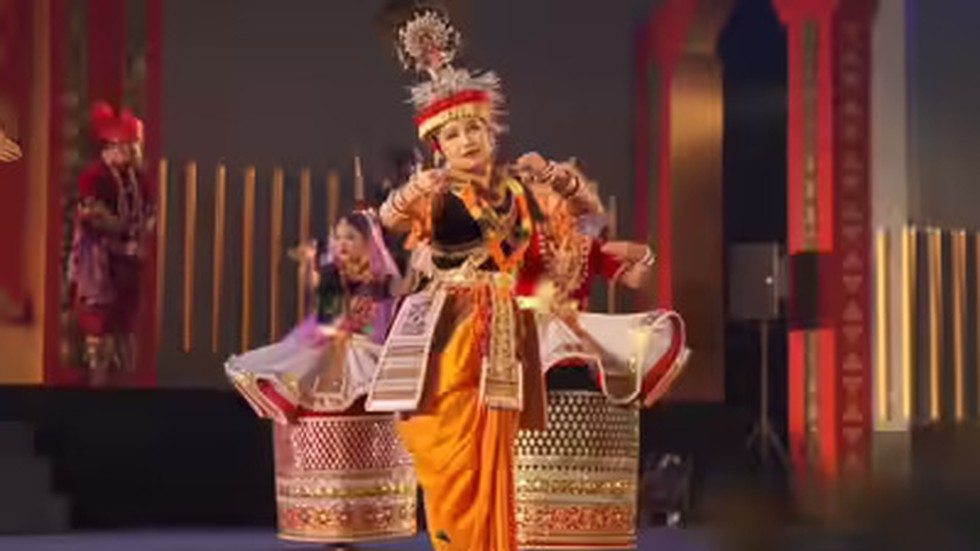
About Sangai Festival:
- It is celebrated in the state of Manipur.
- It is an annual festival, started in the year 2010, which is named after the state animal, the Sangai.
- It aims to showcase Manipur’s rich cultural heritage and indigenous tradition.
- The festival promotes the cultural extravaganza of Manipur through music, dance and various native art forms that are part of the Manipuri tribes and people.
- The state's classical dance form, 'Ras Leela,' renowned for its distinctiveness, takes centerstage during the festival.
- Theme of 2025: Where blossoms breathe harmony
Key Facts about Sangai:
- It is subspecies of Eld’s deer endemic to Manipur.
- It also has immense cultural relevance to Manipur.
- Distribution: It is found only in Keibul Lamjao National Park – the largest single mass of phumdi is in the Loktak Lake – in Manipur’s Bishnupur district.
- Appearance: It is a medium-sized deer, with uniquely distinctive antlers, with extremely long brow tine, which form the main beam.
- Conservation status
- IUCN:Critically Endangered
- Wildlife Protection Act 1972: Schedule-1
Prelims Pointers
Nov. 23, 2025

About Sulphur Dioxide:
- It is a colorless gas with a pungent odor.
- Properties of Sulphur Dioxide:
- It is a liquid when under pressure, and it dissolves in water very easily.
- It has a pungent, irritating odor, familiar as the smell of a just-struck match.
- Occurrence of Sulphur Dioxide:
- Sulfur dioxide in the air comes mainly from activities such as the burning of coal and oil at power plants or from copper smelting.
- It is usually prepared industrially by the burning in air or oxygen of sulfur or such compounds of sulfur as iron pyrite or copper pyrite.
- In nature, sulfur dioxide can be released to the air from volcanic eruptions.
- The largest source of SO2 in the atmosphere is the burning of fossil fuels by power plants and other industrial facilities.
- Applications: It is used to manufacture chemicals, in paper pulping, in metal and food processing.
- Impacts of Sulphur Dioxide: It is harmful for human health, environment and climate.
What is Flue Gas Desulphurisation (FGD)?
- It is a pollution-control process that removes Sulphur Dioxide (SO₂) from the flue gases produced by the combustion of fossil fuels, especially coal.
- FGD systems typically use limestone (CaCO₃), lime (CaO), or ammonia (NH₃) to react with and neutralize SO₂ in flue gases.
Prelims Pointers
Nov. 23, 2025

About Leptospirosis:
- It is a fatal bacterial disease.
- Cause: The disease is caused by a bacterium called Leptospira interrogans, or Leptospira.
- The bacteria can infect humans by entering the body through tiny cracks and wounds in the soles of the feet.
- Prevalence: It is more prevalent in warm, humid countries and both urban and rural areas.
- Transmission of Leptospirosis
- It is a contagious disease in animals but is occasionally transmitted to humans in certain environmental conditions.
- The carriers of the disease can be either wild or domestic animals, including rodents, cattle, pigs, and dogs.
- The cycle of disease transmission begins with the shedding of leptospira, usually in the urine of infected animals.
- Infected animals can continue to excrete the bacteria into their surroundings for a few months, but sometimes up to several years.
- Leptospirosis may occur in two phases
- After the first phase (symptoms: fever, chills, headache, muscle aches, vomiting, or diarrhoea) the patient may recover for a time but become ill again.
- If a second phase occurs, it is more severe; the person may have kidney or liver failure or meningitis.
- Treatment: It can be treated with antibiotics.
Prelims Pointers
Nov. 23, 2025
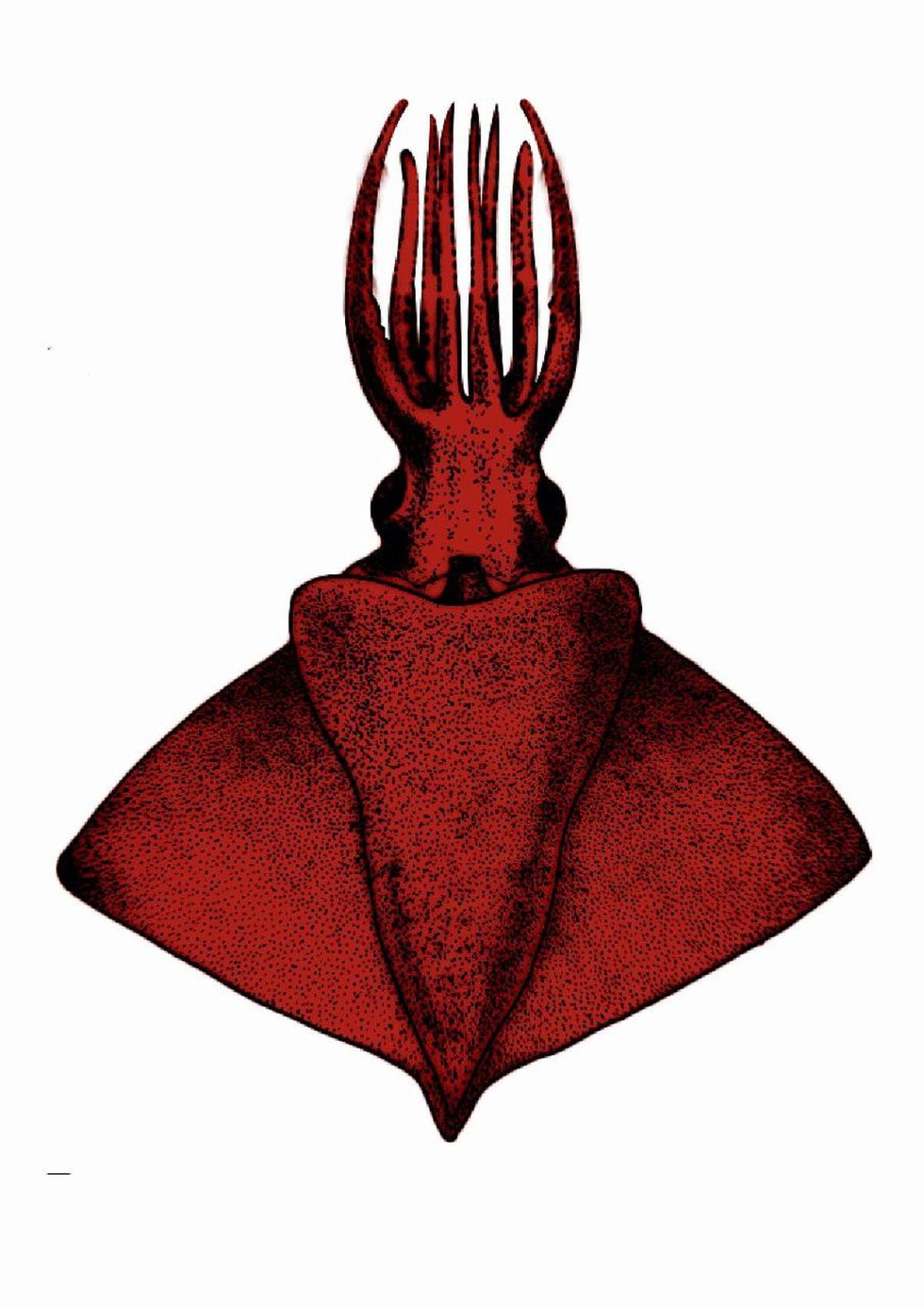
About Taningia silasii:
- It is discovered from the Arabian Sea from nearly 390 metres into the sea off the Kollam coast.
- It belongs to the family Octopoteuthidae.
- It is the only second formally recognised species in the Taningia genus. (Taningia danae was the first species found in the Atlantic Ocean belonging to this genus).
- Characteristics of Taningia silasii:
- It has a length of 45 cm, whereas members of this family can also attain large sizes, with the Atlantic species growing up to 2.3 metres in length and weighing approximately 61.4 kg.
- No Tentacles: One of the most striking features of the Indian octopus squid is the absence of the long feeding tentacles typically seen in most squid species.
- Morphology: It has a reduced number of gill lamellae, which are tiny leaf-like structures on the gills.
- It also possesses a uniquely oval-shaped funnel-mantle locking cartilage and distinct morphological features in its beak, including a broadened wing on the lower beak.
- DNA barcode revealed 11% genetic divergence from its only previously confirmed relative, Taningia danae.
Prelims Pointers
Nov. 23, 2025

About Juvenile Justice Board:
- It is formed under section-4 of the Juvenile Justice Act, 2015 which functions relating to children in conflict with law under this Act.
- It states that, the State Government shall constitute for every district, one or more Juvenile Justice Boards.
- Composition of Juvenile Justice Board:
- A board shall consist of:
- Metropolitan Magistrate or
- A Judicial Magistrate of first class not being Chief Metropolitan Magistrate or
- Chief Judicial Magistrate referred to as Principal Magistrate with at least three years’ experience
- Two social workers selected in such a manner as may be prescribed, of whom at least one shall be a woman.
- Powers of Juvenile Justice Board:
- Under Section 15, special provisions have been made to tackle child offenders committing heinous offences in the age group of 16-18 years.
- The Juvenile Justice Board is given the option to transfer cases of heinous offences by such children to a Children’s Court (Court of Session) after conducting preliminary assessment.
- Functions of Juvenile Justice Board:
- To ensure that the child’s rights are protected throughout the process of apprehending the child, inquiry, aftercare and rehabilitation.
- It also ensures the availability of legal aid for the child through the legal services institutions.
- The board undertakes at least one inspection visit every month of residential facilities for children in conflict with law and recommends action for improvement in quality of services to the District Child Protection Unit and the state government.
- A board shall consist of:
Nov. 22, 2025
Prelims Pointers
Nov. 22, 2025

About Doctrine of Clean Hands:
- The Doctrine of Clean Hands emphasises that those seeking justice must not engage in dishonest practices, ensuring that litigants approach the court with full transparency and integrity.
- It is an equitable principle that prevents a party from receiving relief or asserting a defense if they have acted unfairly or in bad faith concerning the very matter before the court.
- Essentially, a party seeking an equitable remedy must themselves have "clean hands" regarding the dispute to be granted relief.
- Simply put, the doctrine requires that “He who seeks equity must do equity.”
- The doctrine has its roots in the English Court of Chancery, which administered equity.
- Clean Hands Doctrine in Indian Jurisprudence:
- In Indian jurisprudence, the Supreme Court of India has consistently emphasized that litigants must approach the court with “clean hands,” meaning full and honest disclosure of all material facts relevant to the case.
- It would be trite that suppression of material facts implies disclosure of those facts which are essential to the decision-making process.
- If such material facts are suppressed, the Courts have held that the same amounts to fraud on the court, misrepresentation, or abuse of process of law.
- Such conduct disentitles the litigant to any relief, whether interim or final, and may attract exemplary costs, dismissal of proceedings, or even contempt actions.
- The court has described this as a fundamental requirement for invoking equitable jurisdiction, particularly in writ petitions under Article 226 or special leave petitions under Article 136.
Prelims Pointers
Nov. 22, 2025

About Enceladus:
- It is the second nearest of the major regular moons of Saturn and the brightest of all its moons.
- It is Saturn's sixth-largest moon.
- It was discovered in 1789 by the English astronomer William Herschel and named for one of the Giants (Gigantes) of Greek mythology.
- It measures about 500 km in diameter.
- It orbits Saturn in a prograde, nearly circular path at a mean distance of 238,020 km.
- Enceladus is tidally locked with Saturn, keeping the same face toward the planet.
- It continually spews out a concoction of water and simple organic chemicals into space.
- Its surface, which reflects essentially all of the light that strikes it (compared with about 7 percent for Earth’s Moon), is basically smooth but includes cratered and grooved plains.
- The surface is almost pure water ice, with trace amounts of carbon dioxide, ammonia, and light hydrocarbons.
- Because Enceladus is coated in clean, highly reflective ice, it has the brightest surface of any object in our solar system.
- Like other icy moons that orbit gas giants, it's thought that Enceladus maintains a liquid subsurface ocean through tidal heating.
- It is one of the most promising potential sites in the solar system for hosting life.
- Scientists believe Enceladus possesses the chemical ingredients needed for life and has hydrothermal vents releasing hot, mineral-rich water into its ocean, the same type of environment that may have spawned Earth’s first living organisms.
Key Facts about Cassini Spacecraft:
- It is a joint project of NASA, the European Space Agency, and the Italian space agency (ASI).
- Cassini was a sophisticated robotic spacecraft sent to study Saturn and its complex system of rings and moons in unprecedented detail.
- It was launched on October 15, 1997. It was one of the largest interplanetary spacecraft.
- The mission consisted of NASA’s Cassini orbiter, which was the first space probe to orbit Saturn, and the ESA’s Huygens probe, which landed on Titan, Saturn’s largest moon.
Prelims Pointers
Nov. 22, 2025

About Bhoramdev Wildlife Sanctuary:
- Bhoramdev Wildlife Sanctuary, also known as Bhoramdeo Wildlife Sanctuary, is located in the Kawardha district of Chhattisgarh.
- It was notified in the year 2001.
- It is part of the larger Maikal range of the Satpura hills, which is known for its unique ecosystem.
- It is part of the Kanha-Achanakmar Corridor, which connects Kanha National Park in Madhya Pradesh with Achanakmar Wildlife Sanctuary in Chhattisgarh.
- Named after the famous Bhoramdeo Temple situated nearby, the sanctuary covers an area of approximately 352 sq.km.
- Bhoramdeo Temple, an ancient temple complex dating back to the 7th to 11th centuries, was built by the Nagvanshi dynasty.
- The temple is dedicated to Lord Shiva and is often referred to as the “Khajuraho of Chhattisgarh,”.
- The sanctuary’s terrain is characterized by undulating hills, dense forests, and numerous streams.
- The region surrounding Bhoramdev Wildlife Sanctuary is inhabited by various tribal communities, including the Baiga, Gond, and Kanwar tribes.
- Rivers: This wildlife sanctuary is the origin of the Fen and Sankari rivers.
- Vegetation: The sanctuary’s diverse ecosystem includes tropical moist and dry deciduous forests.
- Flora: Lush forests of Saaj, Sal, Tendu, and Nilgiri trees.
- Fauna: It is home to a variety of wildlife, including tigers, leopards, sloth bears, and various species of deer and birds.
Prelims Pointers
Nov. 22, 2025

About Inland Waterways Authority of India (IWAI):
- It is a statutory body established under the Inland Waterways Authority of India Act (IWAI), 1985.
- It came into existence on 27th October 1986 for the development and regulation of inland waterways for shipping and navigation.
- Nodal Ministry: Ministry of Ports, Shipping, and Waterways.
- The Authority primarily undertakes projects for development and maintenance of inland water transport (IWT) infrastructure on national waterways through grants received from the Ministry of Ports, Shipping and Waterways.
- It also takes up techno-economic feasibility studies and prepares proposals for the declaration of other waterways as National Waterways.
- It also advises the Central Government on matters related to IWT and assists States in the development of the IWT sector.
- Headquarters: Noida, Uttar Pradesh
- The Authority also has its regional offices at Patna, Kolkata, Guwahati, and Kochi and sub-offices at Allahabad, Varanasi, Farakka, Sahibganj, Haldia, Swroopganj, Hemnagar, Dibrugarh, Dhubri, Silchar, Kollam, Bhubaneshwar, and Vijayawada.
Prelims Pointers
Nov. 22, 2025
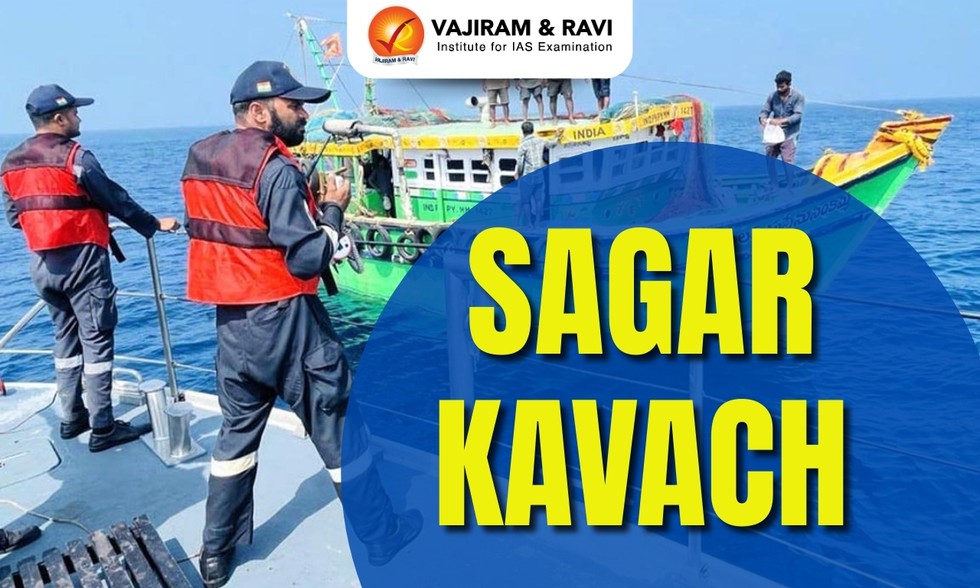
About Sagar Kavach:
- It is a biannual coastal security drill led by the Indian Coast Guard (ICG) that tests and improves coastal security mechanisms against asymmetric threats.
- A wide range of central and state agencies, including the Indian Navy, State Police, Marine Police, Fisheries, Customs, , are part of this exercise.
- The exercise aims to assess the preparedness of all participating agencies in handling coastal security emergencies, preventing attacks on vital coastal installations, and further strengthening the multi-layered Coastal Security Network.
- During the exercise, security forces are split into a "Red team" that simulates infiltrators and a "Blue Team" that detects and neutralises them, assessing inter-agency coordination and response times.
- The key activities of the Sagar Kavach drill generally include heightened surveillance, boat patrols, vehicle checks, and simulated attacks on vital installations to strengthen the country's coastal security framework.
- Recognizing the pivotal role of fishermen in coastal security, the exercise emphasizes the need for their active involvement.
- Fishermen are urged to promptly report any unknown vessels operating in proximity to the coast to the ICG.
Prelims Pointers
Nov. 22, 2025

About Joint Crediting Mechanism:
- It was first proposed by the Government of Japan and was officially launched in 2013.
- Aim: It is a Japanese initiative that aims to facilitate diffusion of leading decarbonizing technologies and infrastructure through investment by Japanese entities and contributes to sustainable development of partner countries.
- It’s a bilateral mechanism which is being implemented in accordance with Article 6 of the Paris Agreement.
- The JCM contributes to the achievement of both countries’ NDC (Nationally Determined Contribution) by evaluating Japan’s contributions in a quantitative manner and acquiring the part of credit.
- It operates under the United Nations Framework Convention on Climate Change (UNFCCC).
- It complements other existing mechanisms, such as the Clean Development Mechanism (CDM) and Joint Implementation (JI).
- India is one of the 31 partner countries of the Joint Crediting Mechanism.
- Focus Area of Joint Crediting Mechanism:
- This mechanism focuses on priority sectors which includes renewable energy with storage, sustainable aviation fuel, compressed biogas, green hydrogen and green ammonia, and in hard-to-abate sectors.
Prelims Pointers
Nov. 22, 2025

About Pharmacogenomics:
- It is the study of how an individual's genetic inheritance affects the body's response to drugs.
- Origin of the Word: The term comes from the words pharmacology and genomics and is thus the intersection of pharmaceuticals and genetics.
- It is part of the growing medical areas of genomic medicine and precision medicine(also called personalized medicine).
- This is a treatment that’s personalized based on your genes, environment and lifestyle.
- Pharmacogenomics is currently used in:
- Oncology: Tailoring cancer therapies based on tumour genetics and patient DNA.
- Cardiology: Adjusting blood thinner dosages based on genetic variants.
- Psychiatry: Selecting the right antidepressant with minimal side effects.
- Infectious Diseases: Predicting patient response to antiviral treatments.
- Importance of Pharmacogenomics
- Improving safety: It improves drug safety, enhances therapeutic outcomes, and reduces healthcare costs associated with adverse drug reactions.
- Targeted drug development: Some conditions are caused by specific changes in a gene. Pharmacogenomics can help researchers discover new medications that directly target the gene change.
Prelims Pointers
Nov. 22, 2025

About Seychelles:
- Location: It is an archipelagic island country located in the western Indian Ocean.
- It is located to the northeast of Madagascar and east of mainland Africa.
- Other major islands near Seychelles include Comoros and Mauritius to the south, and Maldives to the east.
- It consists of an archipelago of 115 islands (only 8 are permanently inhabited).
- Geographical Features of Seychelles
- It is composed of two main island groups: the Mahé group which are mountainous granitic islands and a second group are coralline islands.
- Mahe Group is volcanic with a narrow coastal strip and rocky, hilly interior; others are relatively flat coral atolls, or elevated reefs; sits atop the submarine Mascarene Plateau.
- Highest Point: The highest point in Seychelles is Morne Seychellois.
- Climate: The climate is tropical oceanic, with little temperature variation during the year.
- Capital City: Victoria
What is Colombo Security Conclave?
- It is a regional security grouping comprising India, Bangladesh, Sri Lanka, Maldives, Mauritius, and Seychelles.
- Objective: To promote regional security by addressing transnational threats and challenges of common concern to the member states.
- CSC brings together National Security Advisors (NSAs) and Deputy NSAs of the member countries.
- Secretariat: Colombo, Sri Lanka.
Prelims Pointers
Nov. 22, 2025

About Interstellar Objects:
- Interstellar objects are celestial bodies that originate outside the solar system, and travel through it.
- These objects are not gravitationally bound to a star.
- They can come from other solar systems and be thrown into interstellar space (the area between the stars) due to collisions or be slingshotted by a planet’s or star’s gravity.
- 1I/ʻOumuamua(2017), 2I/Borisov (2019) and Comet 3I/Atlas are the recently known interstellar objects.
- Characteristics of Interstellar Objects:
- Origin: They originate from outside our solar system, often from other star systems or the interstellar medium.
- Hyperbolic Orbit: They basically move in an open-ended hyperbolic orbit, where there is a perihelion point but no aphelion.
- Speed: These objects move at such great speeds that the Sun’s gravitational pull is not able to slow them down enough during their outbound leg.
- Significance of Interstellar Objects:
- Insights into other star systems: Interstellar objects can provide clues about the formation and evolution of other star systems.
- Understanding planetary formation: They can help us understand how planets form and evolve in different environments.
Prelims Pointers
Nov. 22, 2025
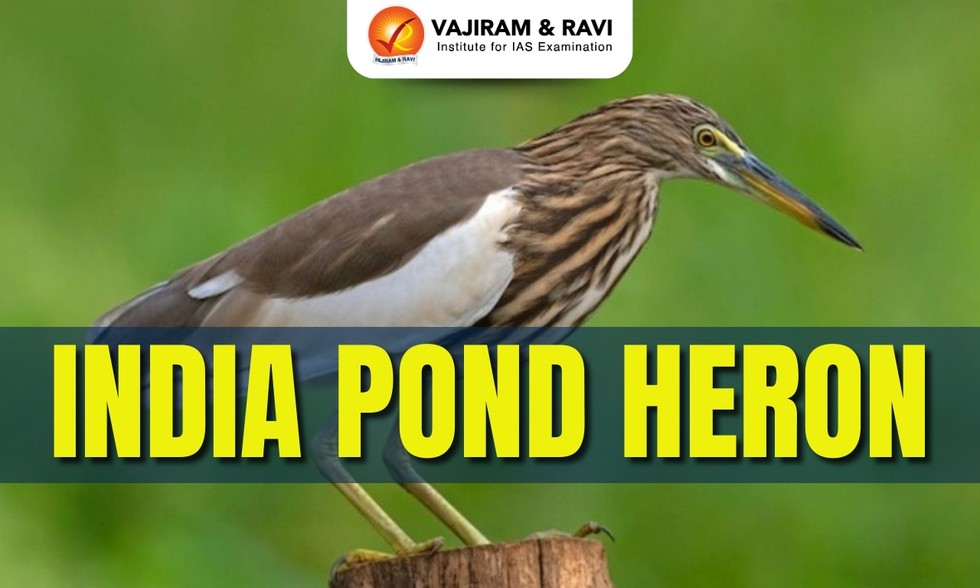
About India Pond Heron:
- Indian Pond Heron or paddybird (Ardeola grayii) is a small heron of Old World origins belonging to the family Ardeidae.
- It acquires maroon hair like plumes on back and a long occipital crest during breeding season.
- Appearance:
- They appear stocky with a short neck, short thick bill and buff-brown back.
- During the breeding season, its plumage exhibits shades of chestnut, while in non-breeding periods, it adopts a more subdued appearance with greyish-brown feathers.
- Habitat: It prefers many types of shallow aquatic habitats, fresh of salt, natural or human made.
- Distribution: It is mainly found in Iran and east to Pakistan, India, Burma, Bangladesh and Sri Lanka.
- Behavior:
- They are semi-colonial breeders and sometimes form communal roosts, often in avenue trees over busy urban areas.
- They are known for their solitary and secretive nature,
- They are often saw standing motionless at the water’s edge, patiently waiting to ambush their prey.
- Diet: The primary food of these birds includes crustaceans, aquatic insects, fishes, tadpoles and sometimes leeches.
- Conservation Status
- IUCN Red List: Least Concern.
- Wild Life (Protection) Act, 1972: Schedule IV.

